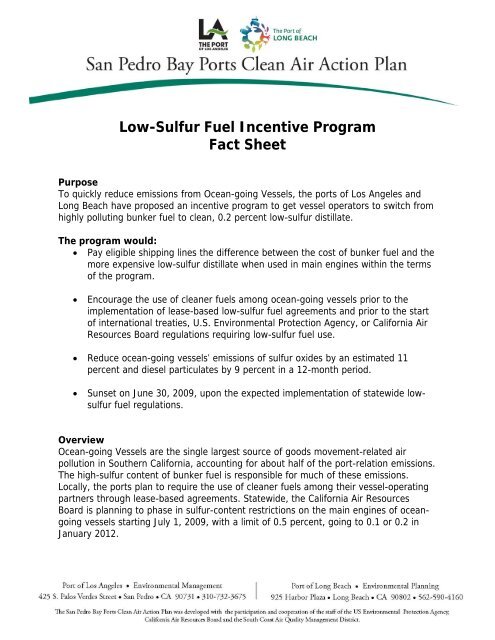Low-Sulfur Fuel Incentive Program Fact Sheet - The Port of Los ...
Low-Sulfur Fuel Incentive Program Fact Sheet - The Port of Los ...
Low-Sulfur Fuel Incentive Program Fact Sheet - The Port of Los ...
You also want an ePaper? Increase the reach of your titles
YUMPU automatically turns print PDFs into web optimized ePapers that Google loves.
<strong>Low</strong>-<strong>Sulfur</strong> <strong>Fuel</strong> <strong>Incentive</strong> <strong>Program</strong><br />
<strong>Fact</strong> <strong>Sheet</strong><br />
Purpose<br />
To quickly reduce emissions from Ocean-going Vessels, the ports <strong>of</strong> <strong>Los</strong> Angeles and<br />
Long Beach have proposed an incentive program to get vessel operators to switch from<br />
highly polluting bunker fuel to clean, 0.2 percent low-sulfur distillate.<br />
<strong>The</strong> program would:<br />
• Pay eligible shipping lines the difference between the cost <strong>of</strong> bunker fuel and the<br />
more expensive low-sulfur distillate when used in main engines within the terms<br />
<strong>of</strong> the program.<br />
• Encourage the use <strong>of</strong> cleaner fuels among ocean-going vessels prior to the<br />
implementation <strong>of</strong> lease-based low-sulfur fuel agreements and prior to the start<br />
<strong>of</strong> international treaties, U.S. Environmental Protection Agency, or California Air<br />
Resources Board regulations requiring low-sulfur fuel use.<br />
• Reduce ocean-going vessels’ emissions <strong>of</strong> sulfur oxides by an estimated 11<br />
percent and diesel particulates by 9 percent in a 12-month period.<br />
• Sunset on June 30, 2009, upon the expected implementation <strong>of</strong> statewide lowsulfur<br />
fuel regulations.<br />
Overview<br />
Ocean-going Vessels are the single largest source <strong>of</strong> goods movement-related air<br />
pollution in Southern California, accounting for about half <strong>of</strong> the port-relation emissions.<br />
<strong>The</strong> high-sulfur content <strong>of</strong> bunker fuel is responsible for much <strong>of</strong> these emissions.<br />
Locally, the ports plan to require the use <strong>of</strong> cleaner fuels among their vessel-operating<br />
partners through lease-based agreements. Statewide, the California Air Resources<br />
Board is planning to phase in sulfur-content restrictions on the main engines <strong>of</strong> oceangoing<br />
vessels starting July 1, 2009, with a limit <strong>of</strong> 0.5 percent, going to 0.1 or 0.2 in<br />
January 2012.
Page -2-<br />
In the interests <strong>of</strong> achieving air quality improvements more rapidly, the <strong>Port</strong>s <strong>of</strong> <strong>Los</strong><br />
Angeles and Long Beach are planning to <strong>of</strong>fer the <strong>Low</strong>-<strong>Sulfur</strong> Main Engine <strong>Fuel</strong><br />
<strong>Incentive</strong> <strong>Program</strong>.<br />
For cargo ships that switch over to 0.2 percent low-sulfur fuel in their main engines<br />
within at least 20 nautical miles and up to 40 nautical miles from Point Fermin, the<br />
ports will pay the incremental difference between the higher cost <strong>of</strong> low-sulfur marine<br />
gas oil and bunker fuel.<br />
To participate in the <strong>Low</strong>-<strong>Sulfur</strong> Main Engine <strong>Fuel</strong> <strong>Incentive</strong> <strong>Program</strong>, ships also must<br />
burn low-sulfur fuel in their electricity-generating auxiliary engines while at berth – as<br />
they do now. And the ships must participate in the ports’ Vessel Speed Reduction<br />
programs, which call for ship speeds <strong>of</strong> no more than 12 knots entering and departing<br />
the ports. Most ships already participate in the speed reduction program, which also<br />
curbs emissions. Carriers must enroll individual vessels into the incentive program in an<br />
application process. Only the ships enrolled in the program will be eligible for<br />
reimbursement. Enrollment will be based on a first-come, first-served basis until the<br />
ports’ budgeted amounts <strong>of</strong> incentives are met.<br />
For the 12 months <strong>of</strong> the program, the <strong>Port</strong> <strong>of</strong> <strong>Los</strong> Angeles could pay up to $8.6 million,<br />
while the <strong>Port</strong> <strong>of</strong> Long Beach could pay up to $9.9 million, in reimbursements.<br />
Environment<br />
<strong>Sulfur</strong> oxides, which contribute to the formation <strong>of</strong> health-threatening soot or<br />
particulate matter, would be cut by an expected 11 percent and particulate matter by 9<br />
percent from ships, accelerating air quality improvements. <strong>The</strong> program would provide<br />
additional emissions reductions faster than the already aggressive schedule set by the<br />
landmark San Pedro Bay <strong>Port</strong>s Clean Air Action Plan.<br />
Review Process<br />
<strong>The</strong> <strong>Los</strong> Angeles Board <strong>of</strong> Harbor Commissioners and the Long Beach Board <strong>of</strong> Harbor<br />
Commissioners have scheduled a March 24 joint meet to consider the <strong>Low</strong>-<strong>Sulfur</strong> <strong>Fuel</strong><br />
<strong>Incentive</strong> <strong>Program</strong>.<br />
<strong>The</strong> meeting will start at 9 a.m. at Banning’s Landing Community Center, 100 E. Water<br />
Street, Wilmington, Calif.
















